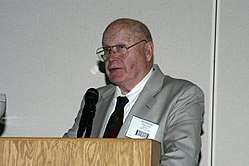Norman A. Phillips

Norman Phillips in 2004
Norman A. Phillips (born July 9, 1923) is an American meteorologist notable for his contributions to geophysical fluid dynamics.[1] In 1956, he developed a mathematical model which could realistically depict monthly and seasonal patterns in the troposphere, which became the first successful general circulation model of climate.[2]
He is a former director of the National Meteorological Center of NOAA NWS.[3] Phillips was awarded a Benjamin Franklin Medal (Franklin Institute) along with Joseph Smagorinsky in 2003.[4]
Phillips was born in 1923.[2] He graduated from the University of Chicago in 1947 with a B.S. and in 1951 with a Ph.D.[4]
Works
- Phillips, Norman A. (April 1956). "The general circulation of the atmosphere: a numerical experiment". Quarterly Journal of the Royal Meteorological Society 82 (352): 123–154. Bibcode: 1956QJRMS..82..123P. doi:10.1002/qj.49708235202.
References
- ↑ Bulletin of the American Meteorological Society (50 ed.). American Meteorological Society. 1969.
|access-date=requires|url=(help) - 1 2 Harper, K. (2009). Weather and Climate: Decade by Decade. Facts on File science library. Facts On File, Incorporated. p. 113. ISBN 978-1-4381-0982-4. Retrieved March 15, 2015.
- ↑ http://www.ncep.noaa.gov/nwp50/Presentations/
- 1 2 "Norman A. Phillips". The Franklin Institute. Retrieved March 23, 2015.
- Cox, John D. (2002). Storm Watchers. John Wiley & Sons, Inc. p. 210. ISBN 0-471-38108-X.
This article is issued from
Wikipedia.
The text is licensed under Creative Commons - Attribution - Sharealike.
Additional terms may apply for the media files.